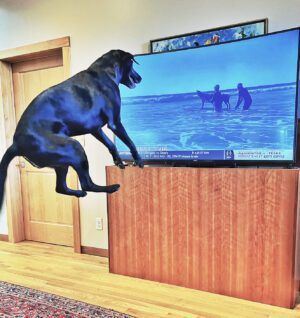
Dogs’ vision is a little different from ours. Their eyes have more rods than cones, so they are more sensitive to motion and have better night vision than humans. Dogs experience colors differently, too. They are more likely to notice the contrast between blue, green, and yellow objects, while red and white are less interesting to them. Despite these differences between dogs’ vision and ours, many dogs watch TV and recognize things that are of interest to them.
What do dogs like to watch on TV? There are lots of things on TV that we watch and dogs ignore, but most dogs recognize and will pay attention to other animals on the screen. For some dogs, this attention will be momentary and be limited to animals – especially dogs – who are running, barking, or engaged in activity, but other dogs will watch any animal doing anything on TV. If a program or commercial features high-pitched sounds, whistles, squeaky toys, or barks, it’s more likely to trigger a response.
Why do some dogs watch TV and others don’t? Young dogs, dogs with little TV experience, or dogs with strong prey drives may act as though animals on television are there in the same room with them, perhaps behind the TV, while some dogs realize right away that the images aren’t real. The fact that televised animals don’t smell like anything probably makes them less interesting, as dogs depend as much on their amazing sense of smell as their vision.
Your dog may have already demonstrated that televised animals are fascinating, but if that hasn’t happened yet, pay attention when pet food ads, commercials featuring dogs, or nature programs come on. If their colors are mostly blues, greens, or yellows, the action should capture your dog’s attention. Look for focusing eyes, alert expressions, changes in posture, head tilts, tail wags, or expressive sounds like growls, barks, or whines. You’ll be able to see whether your dog is interested, enjoying herself, uncomfortable, or indifferent.
Should you leave the TV on for your dog?
That depends on your dog and the programs. Some veterinarians discourage the practice because they have seen dogs who have injured themselves while chasing something on the screen or dogs who have been frightened, confused, or stressed by sights and sounds. Action movies may interest dogs because of their motion, but dogs are less likely to enjoy explosions, fireworks, arguments, or gunfire. Make it easy for your dog to stay or leave the TV area while you’re away. Behavioral experts remind dog owners that televisions can’t substitute for human companionship, but familiar sights and sounds may help dogs relax or entertain themselves during the day.
There is even a TV channel for dogs. As the DogTV website explains, “We’ve worked with experts like Professor Nicholas Dodman at Tufts University, Niwako Ogata of Purdue University, and organizations like the Center for Canine Behavior Studies to learn from their observations.” The channel’s colors and high number of frames per second coordinate with canine vision, and its offerings range from stress-reducing scenes of dogs relaxing to dogs enjoying more stimulating activities, such as surfing at the beach.


